Join the Digital Anniversary Around the World, April 22
Explore our Earth Day Digital Activities
Grace Farms Foundation aspires to advance good in the world, providing a peaceful respite and porous platform to experience nature, encounter the arts, pursue justice, foster community, and explore faith.
In April, we had planned to join the world in celebrating the 50th anniversary of Earth Day with events at Grace Farms. But the global outbreak of coronavirus (COVID-19) has temporarily closed our 80-acre preserve and River building. Undoubtedly, it has changed all of our lives, not only how we interact with each other but with nature. Perhaps the disruption of our routines will create space to explore and appreciate nature at a deeper level: Join us in the worldwide digital celebration on April 22 and connect with nature through the safety of our homes, safe open spaces, books, online resources, and digitally, with each other.
Despite the warnings about our planet – and yes, there’s still much work to do to mitigate climate change – this past half-century tells a compelling narrative of how a committed group of individuals and communities can change the course of history, from reversing some of the damage to our native habitats and wildlife, to creating regulations to revitalize and protect our waterways in the 1970s, to building pollinator pathways today.
At Grace Farms, we have restored almost 77 acres of native habitats and preserves, including meadows and woodlands. Our efforts have brought back more than 100 species of native birds and pollinators, among other wildlife. This connection with nature extends throughout our award-winning River building. With more than 200 floor-to-ceiling panes of glass, we’ve essentially removed the visual barriers between the built and natural environment.
This intentional relationship cultivates a peaceful, welcoming environment for all and helps stimulate new perspectives.
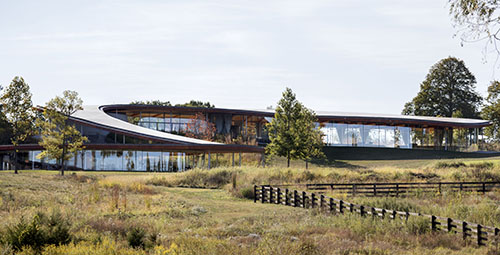
The SANAA-designed River building breaks down barriers between nature and architecture. © Dean Kaufman
Even though COVID-19 continues to weigh heavily on all of us, it’s a good time to acknowledge what matters in our lives, not only for our families and communities, but also for the well-being of our earth.
So, join us this Earth Day in a digital celebration and let us know how you plan to participate: post your photos and thoughts and tag us on Facebook, Twitter, and Instagram @GraceFarmsCT.
#EarthDay2020 and #EARTHRISE
Five Decades of Advancements That Gives Us Hope
June 22, 1969 – The Fire Seen Around the World
The 1969 fire on the Cuyahoga River in Cleveland, Ohio has come to symbolize the start of Earth Day and the subsequent creation of laws and regulations that now protect the environment, including the Clean Water Act. This wasn’t the first time a section of the nearly 85-mile river caught fire. There had been decades of unregulated industrial growth with little foresight on how disposing of hazardous waste into our nation’s rivers would one day impact our ecosystems. This image of the oil-soaked river on fire, flames engulfing a tug boat, was featured on the cover of Time magazine soon after the June 1969 fire.

The 1969 fire on the Cuyahoga River in Cleveland, Ohio. © Time Magazine

In 1964, Cleveland City councilmen inspect pollution in the Cuyahoga River. © Cleveland State Library Special Collections
April 22, 1970 – The Start of Earth Day
“The opportunity for a gradual but complete break with our destructive environmental history and a new beginning is at hand … We can measure up to the challenge if we have the will to do so — that is the only question. I am optimistic that this generation will have the foresight and the will to begin the task of forging a sustainable society.” – Former U.S. Senator Gaylord Nelson and Founder of Earth Day (Wisconsin Historical Society)
Much the same way the image of the Cuyahoga River fire raised our awareness about how industry was damaging our environment, a massive oil spill in Santa Barbara, Calif., also in 1969, inspired Senator Nelson to came up with the idea for a national day to focus on the environment. Senator Nelson proposed a day people would host teach-ins to address environmental concerns. He believed if students, already engaged in the anti-war movement across the country, got involved, it would push lawmakers to listen and act. His proposal for a national “teach-in” day was picked up by the national media, attracting over an estimated 20 million people to Earth Day marches and events.
“Congress adjourned so members could speak across the United States and at least 2,000 colleges marked the occasion.” – The New York Times.

An estimated one million people in New York City joined marches around the country to raise awareness on Earth Day, April 22, 1970. © New York City Department & Information Services
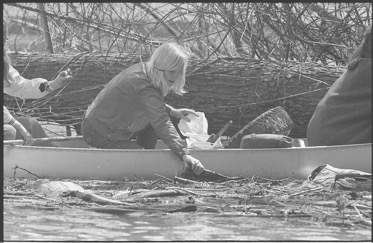
Girl Scout in canoe, picking trash out of the Potomac River, April 22, 1970. © Library of Congress. U.S. News & World Report Magazine Photograph Collection, Thomas O’Halloran, photographer.
Earth Day, April 22, 1980 – Decade of Protective Legislation
In April 1980, Gaylord Nelson, the founder of Earth Day, reflects back on the accomplishments of the environmental movement. He also addressed the concerns that the movement is waning because “new worries” such as the energy crisis have captured the nation’s attention. “To anyone who has paid attention, it is clear that the environmental movement now is far stronger, far better led, far better informed, and far more influential than it was ten years ago,” he writes in the Environmental Protection Agency Journal.
Legislation enacted over the 1970s to protect and restore the environment include:
- Clean Air Act,
- Water Quality Improvement Act,
- Water Pollution and Control Act Amendments,
- Endangered Species Act,
- Safe Drinking Water Act

Senator Nelson overlooks the St. Croix River, which runs between Minnesota and Wisconsin. His efforts to protect this waterway resulted in St. Croix becoming the first wild and scenic river in the country. © Nelson Collection
Earth Day, April 22, 1990 – President Officially Proclaims April 22 “Earth Day”
The proclamation also coincides with Earth Day becoming a global movement. About 200 million people around the world, from 141 countries, participated in celebrations and actions to protect the environment.
The movement that some feared was in danger of waning during the 1980s, overshadowed by other global concerns, gained the attention of President George H. W. Bush. In January of 1990, he proclaimed Sunday, April 22 as Earth Day. “Earth Day – and every day – should inspire us to save the land we love, to realize global problems have local solutions, and to make the preservation of our planet a personal commitment,” he said (EPA Earth Day News).
Earth Day, April 22, 2000 – Bald Eagle Makes a Comeback
During this decade, the bald eagle, our nation’s symbol, which was on brink of extinction, was removed from the Endangered Species List in 2007. There were fewer than 500 eagle pairings in the 1960s, and by 2009 there were an estimated 16,048 pairs, according to the U.S. Fish and Wildlife Service. There are numerous reasons for the decimation of their population, including habitat loss.
Earth Day, April 22, 2010 – Humpback Whale, Seals Back in Long Island Sound
After many years absent from Long Island Sound, the humpback whale, seals, and other fish have returned to the Sound. For decades, Long Island Sound was unfit for marine wildlife as well as human beings. In the 1980s, pollution and poorly treated sewage led to the elimination of wildlife and waters nearly devoid of oxygen. But since the 1990s, the state Department of Energy and Environmental Protection and other state environmental groups have made a commitment to restore the Sound’s ecosystem.
These comeback stories are prime examples of how we can envision a better future together. Rather than solely considering the problem, perhaps in the words of Sharon Prince, our CEO and Founder, we need to “envision what can be, who can make a commitment, and then vigorously work to accomplish it.”
Restoration of Grace Farms’ Native Perserves Brings Back Wildlife
Restoring the natural habitat and installing nesting boxes at Grace Farms have brought back another bird of prey to our site, the American Kestrel. The Kestrel, one of the smallest and most common North American falcons, helps farmers by consuming crop pests. This helps reduce the amount of crop damage and financial loss.
Our CEO and Founder made a commitment to restoring our expansive landscape, and integrated long-term plans for this restoration in the architectural and landscape design of Grace Farms. We now have 10 restored habitats including: emergent marshes, fields, gardens, pastures, ponds, wet meadows, and wooded swamps. In addition to the Kestrel, we are also home to a variety of wildlife including the wood frog, snapping turtle, and osprey. In addition, through our Nature Initiative, we offer more than 35 weeks of free nature programing to encourage people to connect with nature and to embrace the stewardship of our natural environment.
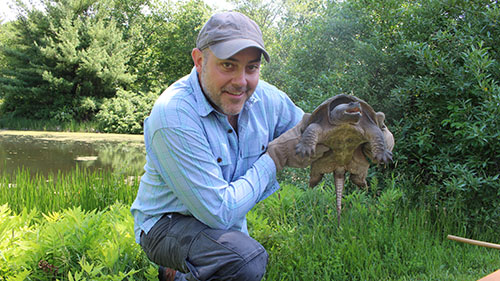
Mark Fowler, former Nature Initiative Director with our resident snapping turtle at our Cattail Pond. © GFF
A few of our outcomes include:
- Collecting over 8,000 pounds of trash during the annual Source to Sound Cleanup in partnership with the Connecticut River Conservancy.
- Restoring 10 different habitats at Grace Farms, including emergent marsh, fields, gardens and brush, wooded bedrock knolls, pastures, mixed hardwood forest, old fields, pond, wet meadows, and wooded swamp.
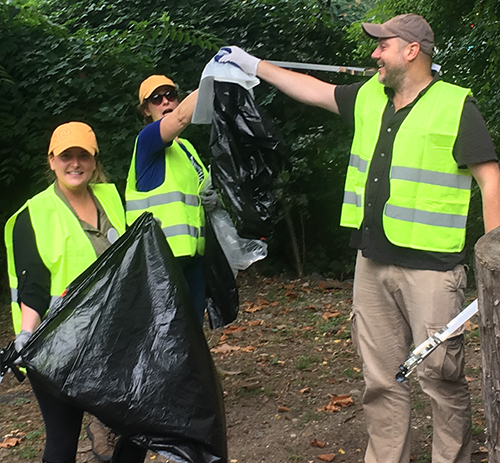
Our annual Source to Sound Cleanup @GFF
- Joining the local and regional Pollinator Pathway movement to protect and increase natural habitats for pollinators. To that end, Grace Farms installed thousands of native plants as part of our nature-based solutions.
- Increasing the number of native birds on site to more than 100 bird species, up from more than 60 in 2017. Some species include: American Kestrel, Eastern Bluebird, Eastern King-bird, Indigo Bunting, Northern Oriole, Eastern Towhee, Willow Flycatcher, and Osprey that have been seen at Grace Farms during migration.
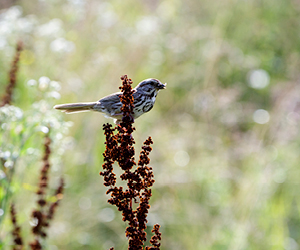
One of the many native birds at Grace Farms. © Julien Jarry
Earth Day, April 22, 2020 – 50th Year Anniversary
While our work is far from over, these past 50 years should give us cause to be hopeful and to celebrate. As Senator Nelson suggested, each of our actions to advance the common good extends beyond ourselves and communities.
“Our goal is not just an environment of clean air and water and scenic beauty. The objective is an environment of decency, quality and mutual respect for all other human beings and all other living creatures.” ― Gaylord Nelson
Sign up for our newsletter to learn more about Grace Farms’ programs and our initiatives: nature, arts, justice, community, and faith.

